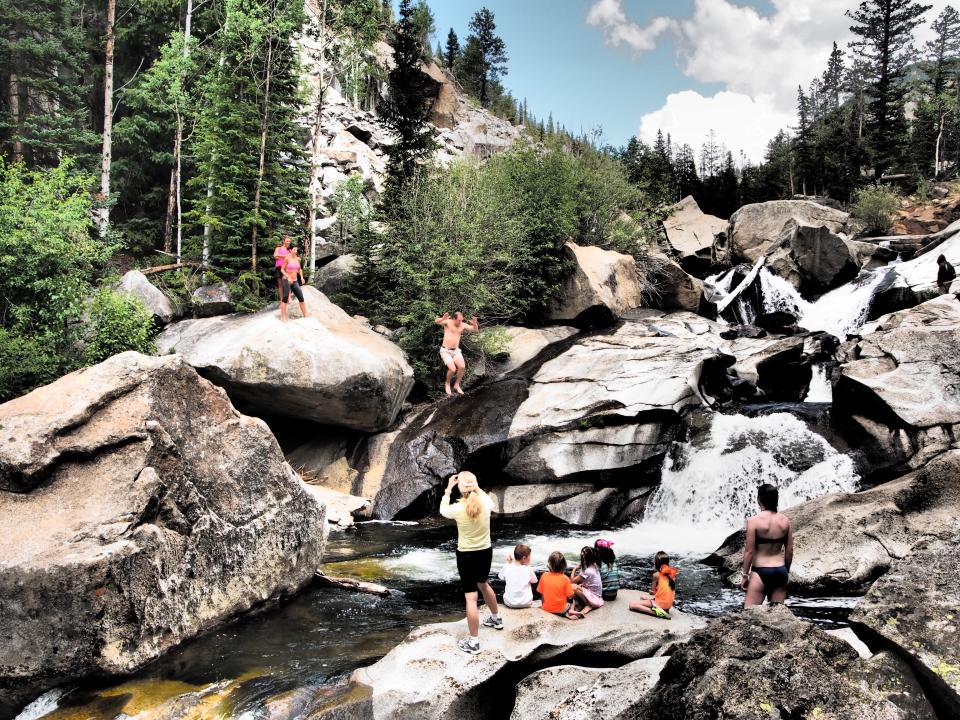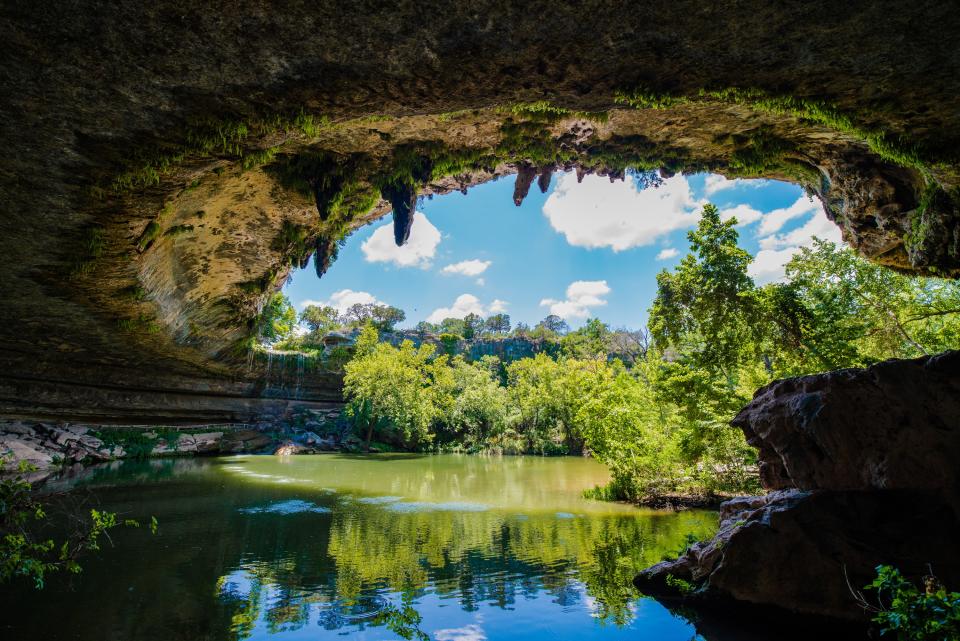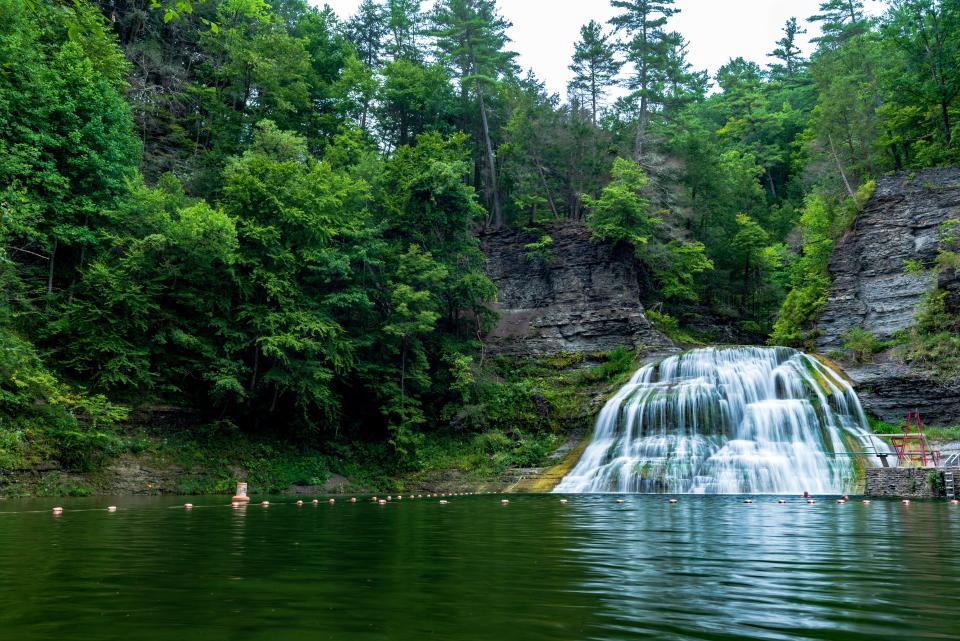8 Stunning U.S. Swimming Holes to Cool off in This Summer
Summer is almost here, and with it comes face-melting temperatures that will have you pining for sweet relief at pools and beaches. But there’s another, more unique way to cool down—taking a dip in a natural swimming hole. What follows are eight of our favorites from coast to coast, including a triple-tiered waterfall pool in New York’s Finger Lakes Region, a slippery natural water slide in Arizona, and a hangout for manatees in Central Florida.
All listings featured in this story are independently selected by our editors. However, when you book something through our retail links, we may earn an affiliate commission.

Devils Punch Bowl
Devil’s Punchbowl, CO
Ominous name aside, this swimming hole off the Roaring Fork River near Aspen is a blessing on a sweltering summer day. The ice-cool pool is accessible between late May and October, but best visited in June, July, and August, when its cyan pools are at their highest water levels. The hole is unmarked but can be reached by parking between mile markers 50 and 51 on Highway 82, a.k.a. Independence Pass, a thrilling scenic route about 10 miles east of Aspen. Hike down about 200 feet and you’ll know you’ve found the spot when you see cliff jumpers flinging themselves off the 10-, 18-, and even 25-foot boulders flanking a thunderous waterfall. There is no lifeguard on duty here, so swimming (and jumping) is always at your own risk. Ask the locals about water conditions and avoid hopping in if it has recently rained, as dangerous undercurrents after a storm can overpower even the strongest swimmers.
North Chick Blue Hole, TN
The Blue Hole, as locals call it, is one of the best-known swimming holes near Chattanooga. Located in the North Chickamauga Creek Gorge, about 20 minutes from downtown, the pool sits in a basin between Signal and Mowbray mountains in the Pocket Wilderness hiking area. (Pack your favorite water shoes, because you’ll have to hike a mile in and out, crossing a rocky creek en route.) The waters that await you on the other side are cool and clear, with shallow spots for kids to splash around, flat boulders for picnickers and sunbathers, and a deeper end for daredevil rock jumpers.
Fanning Springs State Park, FL
Swimming, snorkeling, and scuba diving are popular pastimes at this beloved state park 50 minutes east of Gainesville. Here, crystalline jade water from the Suwannee River remains at a cooling 72 degrees year-round. Climb the observation platform for a bird’s eye view of the swimmers, or stake out a spot in the gazebo sandwiched between the springs and a swamp. No-frills campsites are open for guests arriving on foot, by bicycle, or via canoe or kayak on the Suwannee River Wilderness Trail; modern cabins with air-conditioning, electric fireplaces, and screened porches are available to travelers seeking more creature comforts. A strollable .75-mile path leads guests past sinkholes and through a hardwood and pine forest where some trees tower nearly six stories high. Keep an eye on the water for gentle manatees, the forest for bounding white-tailed deer, and the treetops for red-shouldered hawks.
Hamilton Pool Preserve, TX

Guide to Swimming Holes, Hamilton Pool Preserve, Texas
GettyThe Lone Star State has no shortage of emerald green swimming spots, from bustling Barton Springs Municipal Pool in Austin’s Zilker Park to the bone-chilling Blue Hole Regional Park in Wimberley. Inviting as those holes are on a humid afternoon, they can’t rival the storybook majesty of Hill Country’s Hamilton Pool, a collapsed grotto 30 miles west of downtown Austin. The crown jewel of a 232-acre preserve, its 50-foot waterfall gushes over a limestone outcrop, making for wildly dramatic photos. The falls can slow to a trickle in drier weather, but the pool water remains consistently high. Online reservations are always required to visit, as the area is occasionally closed due to high bacteria levels, falling rocks, or other safety concerns; note that officials recently closed the pool from swimming due to rockslides.

Robert H. Treman State Park, New York
Robert H. Treman State Park, NY
Follow the wooded trails through Enfield Glen in Robert H. Treman State Park in Ithaca and you’ll happen upon a dozen waterfalls. The dashing Lucifer Falls, a 115-footer with a 1.5-mile view to the bottom of the ravine, is a scene stealer, but don’t dive here. To swim, you must head for the waterfall-fed pool located at the base of Enfield Falls, at the other end of the park. This lifeguarded area has a 30-foot cascading waterfall with a viewing platform, a diving board perched above the deep end, a shallow swim area roped off for families, and a flat-pebble beach for sunbathers.
Falling Water Falls, AR
While roadtrippers can drive right up to this idyllic swimming hole in Ozark National Forest to snap a picture of its hypnotizing falls from the passenger seat, it’s far more rewarding to go for a wade. The falls, which spill into a placid pool with waist-deep turquoise water, are one of many located along a 15-mile scenic drive just south of the Richland Creek Wilderness Area. For the most dazzling photo ops, time your visit shortly after a heavy rain. Just come prepared: A 4WD vehicle with high clearance is recommended for the rutted dirt road, as is downloading an offline map before you set out; cell service is abysmal in these parts.
Slide Rock State Park, AZ
Before Slide Rock State Park, just a few miles north of Sedona, became one of Arizona’s most popular tourist attractions, it was the humble estate of homesteader Frank L. Pendley. He arrived at the breathtaking red-rock canyon in 1907, acquired 43 acres through the Homestead Act in 1910, and figured out a novel way to irrigate the land and plant an apple farm by 1912. The orchard still exists, but it’s the 80-foot-long slippery sandstone rock shoot at the edge of the property that draws travelers. The slide empties into a half-mile swimming and wading part of Oak Creek Canyon located on National Forest land. There are 25 open-air picnicking areas and three short trails here, averaging about a quarter mile each. Along the Slide Rock Route, note the old rock cabin west of the creek—Pendley used this, in conjunction with a flume and water wheel, to generate his own electricity.
McCloud Falls, CA
This trio of waterfalls dotting the McCloud River, an hour and a half north of Redding, California, can be visited year-round. But they’re especially beguiling in summer, when you can backstroke in the pool at the base of the Lower Falls. The water here is always chilly (low 50s) and jumping in is discouraged due to submerged boulders, but it’ll still feel real good after hiking the McCloud River Trail, a 15-mile route through Shasta-Trinity National Forest. For a shorter but equally scenic excursion, hike 1.3 miles upstream to the 50-foot Middle Falls, which span 100 feet across and are arguably the most enchanting of the three cascades. It’s another half mile to the secluded Upper Falls’ viewing platform, lofted 90 feet above the river. Nearby Fowlers Camp Campground is a popular spot to pitch your tent; 31 of its 39 campsites must be reserved in advance.
Originally Appeared on Condé Nast Traveler

